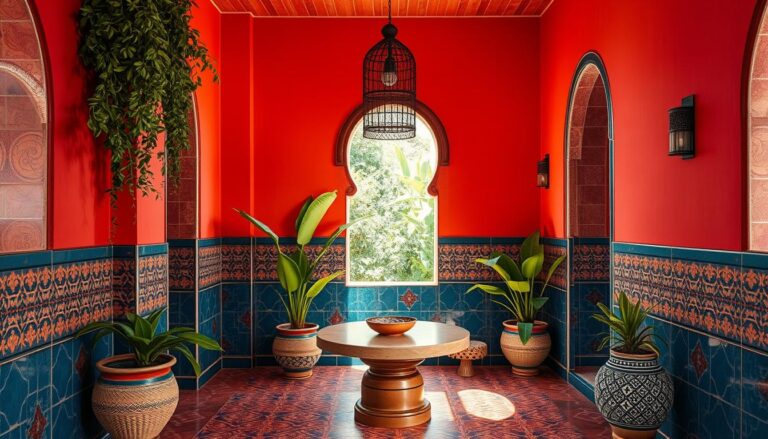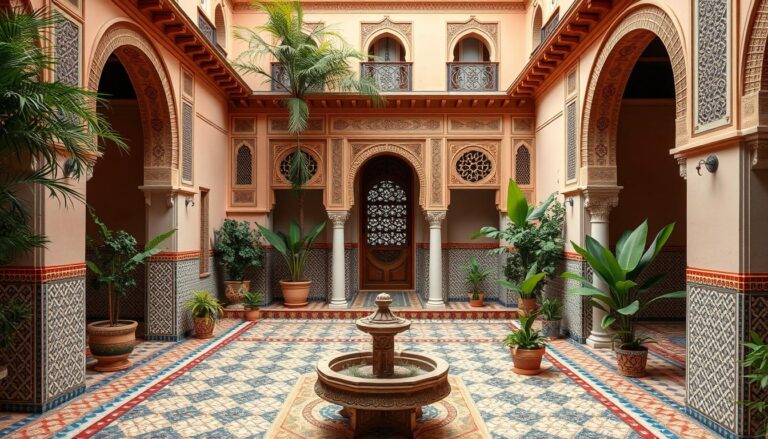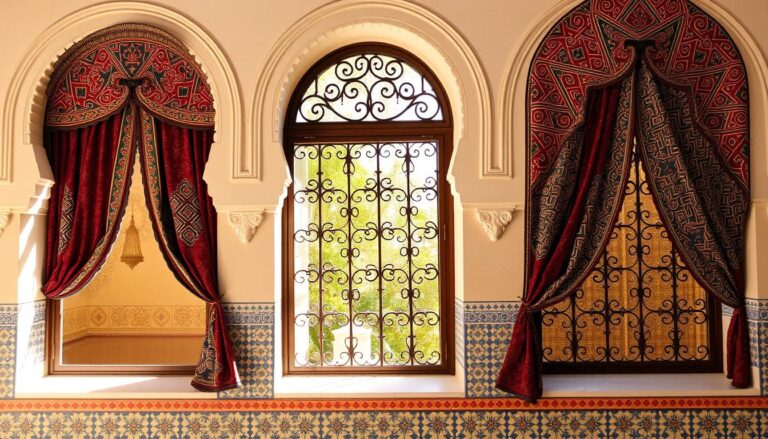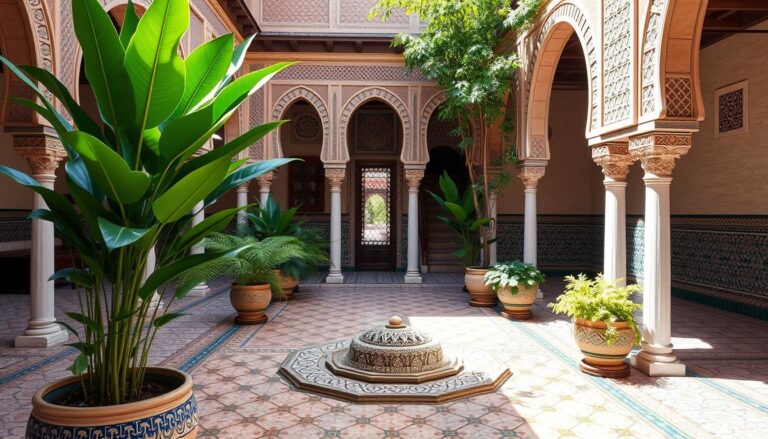What secrets hide in the intricate patterns and colorful zellij tilework of Morocco’s mosques, palaces, and cities? Explore the fascinating world of Islamic architecture in Morocco. This legacy has amazed people around the world for centuries.
Key Takeaways
- Morocco’s Islamic architectural heritage spans over 600 years. It was shaped by the Hispano-Moorish style, mixing European and Arab influences.
- Places like the Kutubiyya Mosque, Ben Youssef Medersa, and Hassan II Mosque show how this style evolved.
- Moroccan architecture is known for its detailed geometric patterns, ornate calligraphy, and use of materials like stucco and zellij tiles.
- Mosques, madrasas (Islamic schools), and riads (traditional Moroccan homes) highlight the country’s Islamic heritage.
- Morocco’s architectural legacy has been influenced by dynasties like the Almoravids, Almohads, and Merinids. Each left its unique mark on the country’s buildings.
Ancient Origins: Berber and Roman Influences
Morocco’s architecture has deep roots in ancient Berber kingdoms and Roman settlements. The Berbers, native to North Africa, built kasbahs and ksour from red mud clay bricks. These structures were strong and well-made.
Important Roman cities in Morocco were Tingis (now Tangier), Sala (Chellah), and Volubilis. Volubilis was especially notable. It had amazing buildings like aqueducts, a forum, baths, and stunning Roman mosaics.
Phoenician and Roman Settlements
The Phoenicians, known for their sailing skills, set up settlements on Morocco’s coast in the 8th century BCE. Their presence paved the way for the Romans to come later.
By the 1st century CE, the Romans took control of much of Morocco. They built many architectural wonders, like aqueducts, forums, and fancy villas with detailed mosaics.
Volubilis: Morocco’s Roman Jewel
Volubilis, in northern Morocco, shows the Romans’ architectural skill. At its height, it had 20,000 people and many impressive buildings. The Capitol and the grand Basilica were among them.
“Volubilis was a well-developed Roman municipium, with aqueducts, a forum, baths, and fine Roman mosaics.”
The Arch of Caracalla, built in 217 CE, and the mosaics in the House of Orpheus and the House of the Labours of Hercules highlight Roman art and engineering in Morocco.
The Dawn of Islamic Architecture (8th-10th Century)
The early 8th century was a big change for the region. It became part of the Muslim world with the Idrisid dynasty’s arrival. This change deeply affected Morocco’s architecture, especially in Fes, founded by the Idrisids.
Fes: The Cradle of Early Islamic Moroccan Architecture
In this time, Fes saw the rise of important Islamic buildings. The Al-Qarawiyyin Mosque and Andalusiyyin Mosque were among the first. They were built with the horseshoe or Moorish arch, showing the influence of the Great Mosque of Kairouan and Great Mosque of Cordoba.
This Moorish design became a key feature of early Islamic architecture in Morocco.
“The Al-Qarawiyyin and Andalusiyyin Mosques in Fes were architectural gems that showcased the burgeoning Idrisid dynasty’s commitment to establishing Fes as the cradle of early Islamic architecture in Morocco.”
These early Islamic architectural wonders in Fes showed the Muslim world’s influence. They also set the stage for the unique Moroccan style that would follow.
Islamic Architectural Heritage in Morocco
Moroccan architecture is a mix of Berber, Islamic, Moorish, and French colonial styles. This blend shows the country’s rich history and cultural diversity. Modern buildings are becoming more common, but ancient structures like Berber kasbahs and Islamic mosques still dominate.
The Islamic architectural heritage in Morocco is truly impressive. Many mosques, madrasas, and palaces show the skill of Moorish architects. These buildings are adorned with zellij, a traditional Moroccan tilework. It uses vibrant colors and patterns, showing the beauty of math and design.
“Zellij reached its peak during the Marinid dynasty (1244-1465), with prominent examples including the Bou Inania and Al-Attarine Madrasas in Fez.”
Berber architecture is also a big part of Morocco’s heritage. Mud-brick kasbahs and ksour are found in hills and oases. They show how local communities adapted to their environments.
The French colonial era had a big impact on Moroccan cities like Casablanca and Rabat. It brought European architectural styles that blend well with Islamic and Berber influences. This mix creates a unique and captivating visual landscape that draws visitors worldwide.
The Berber Empires: Almoravids and Almohads (11th-13th Centuries)
The fall of the Cordoban caliphate in the early 11th century opened the door for the rise of major Berber empires in Morocco. The Almoravids (1062-1147) and the Almohads (1147-1269) were two dynasties that greatly influenced the region’s architecture.
Almoravid Architectural Innovations
The Almoravids were a militant Islamic movement among the Ṣanhājah tribes. They took control of Morocco and parts of North Africa. In 1070, they made Marrakech their capital, bringing architectural styles from al-Andalus.
They played a key role in stopping Christian kingdoms in al-Andalus. This united the Maghreb and al-Andalus politically for the first time.
Almohad Masterpieces: The Kutubiyya and Beyond
The Almohads, led by Muḥammad ibn Tūmart, took power after the Almoravids fell. They ruled the Maghrib and Muslim Spain from 1148 to 1172. Unlike the Almoravids, they didn’t have a clear religious focus and faced internal struggles.
Yet, they left a lasting impact on Moroccan architecture. The Kutubiyya Mosque in Marrakech and the Hassan Tower in Rabat are their masterpieces.
The Almohad style is known for its strict, geometric design. This is seen in the walls of Fez, Rabat, and Marrakech. Mosques like Taza, Tinmal, and the Qasba in Marrakech also show this style.
These structures set the stage for the beautiful forms and motifs that followed in later centuries.
“The Almoravids and Almohads were crucial in shaping the architectural identity of Morocco, laying the foundation for the refined forms and motifs that would emerge in the centuries to come.”
The Marinids’ Golden Age (13th-15th Centuries)
The Marinid dynasty ruled Morocco from 1244 to 1465. This was a golden age for Marinid architecture. The rulers supported the arts, building many mosques, madrasas, and structures in Fes and Meknes.
The Marinid architecture is known for its ornate details. Even in buildings like fortifications, these details were key. The Bou Inania, Attarine, and Sahrij madrasas in Fes are famous examples of this style.
“The Marinid Dynasty rose to power around 1244, establishing itself after defeating the Almohads and consolidating control over Morocco. Under the Marinids, there was a significant emphasis on education and culture, leading to the establishment of universities and libraries in cities like Fez.”
Trade flourished during the Marinid era. The dynasty traded with Europe and sub-Saharan Africa. This helped the region’s prosperity. But, the Marinid Dynasty declined in the 15th century due to internal strife and external pressures.
Even though the Marinid Dynasty declined, their architecture still shapes Morocco’s culture. It shows the country’s rich Islamic heritage and the lasting impact of Marinid architecture.
Conclusion: Morocco’s Enduring Architectural Legacy
Morocco’s buildings show the country’s deep cultural roots. They mix Berber, Islamic, Moorish, and French colonial styles. This mix makes Morocco’s architecture truly unique.
From old Berber kasbahs to grand Islamic mosques, Morocco’s buildings are a sight to see. They show the country’s rich history and artistic talent. The Moroccan architecture is a blend of many styles, each with its own special touch.
The Moroccan government and UNESCO work hard to keep these buildings safe. They help cities like Fez stay true to their heritage. This work also supports local artisans, keeping tilework and stucco carvings alive. Morocco’s architecture is a lasting symbol of its people’s history and culture.
Source Links
- Islamic Architecture in Morocco, Your Morocco Travel Guide |
- Moroccan Architecture: In-Depth Review of Styles in Morocco
- Moroccan Architecture History | Global Morocco Exploration
- From Islamic to Art Deco: A rich history of Moroccan architecture
- Moroccan architecture
- Exploring Roman Morocco
- Islamic architecture
- The Islamic Golden Age | World Civilization
- Discovering Islamic Patterns in Morocco
- Cultural Heritage of Zellij in Moroccan Architecture | Paris Tile
- Moroccan Architecture & Heritage Arts "Marrakech" – IEREK
- North Africa – Almoravids, Almohads, Maghrib | Britannica
- The Art of the Almoravid and Almohad Periods (ca. 1062–1269) | Essay | The Metropolitan Museum of Art | Heilbrunn Timeline of Art History
- Almoravid dynasty
- Moorish architecture
- The Marinid Dynasty
- Marinid Dynasty – (History of Africa – Before 1800) – Vocab, Definition, Explanations | Fiveable
- Preserving Islamic Architecture in Fez, Morocco – The Continents States University
- Exploring the Timeless Beauty of Moroccan Architecture | African Sahara
- Ancient Morocco: Insights into the Moroccan Empire

The Editorial Team is a passionate group of Morocco enthusiasts dedicated to sharing the beauty, culture, and wonders of this captivating country. With diverse backgrounds and a deep love for travel, we strive to bring you engaging and informative content that inspires your Moroccan adventures. From uncovering hidden gems and sharing local insights to exploring mouthwatering cuisine and showcasing the vibrant lifestyle, our team is committed to providing you with valuable resources and exciting stories that enhance your exploration of Morocco. Join us on this journey as we celebrate the rich heritage and unforgettable experiences that make Morocco truly special.







